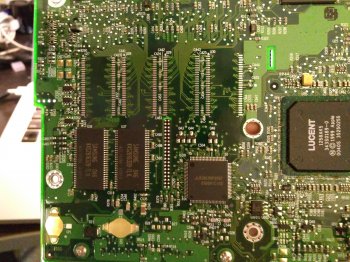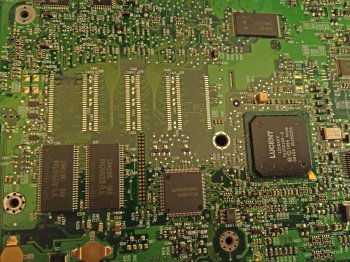Hi. Longtime, but occasional reader here.
So I've owned a couple of Rev. C clamshells (an indigo and a 466 key lime) over the last dozen years.
With the latter, I restored it partially earlier this year — adding a 128GB SSD, a DVD-RW (which mates to the original bezel), and an LG XGA 1024x768 LCD (using shifuimam's fantastic sleuthing back in 2007 on another long gone forum), with its anti-glare sheet removed (yet another hack found elsewhere). The modem card was also removed for a future project. In all, it's lighter, quicker, and more versatile than Apple ever intended for it.
I'm throwing this to the brave souls (@LightBulbFun, @dosdude1, and others) who've successfully made the G4 chip swap on PPC750L (Rev. A & B) clamshells, namely because they've likely had more close-up face time with the clamshell logic board than most folks.
On the overside and underside of the northbridge logic board (with Rev. C logic boards), one can make out the locations on either of the board side where onboard memory modules are soldered (providing 64MB of onboard memory for Rev. C, and 32 MB for Rev. A & B).
On the underside of the Rev. C (and ostensibly on the underside of Revs. A & B), there's an additional area adjacent to the underside soldered memory where space allocations for four more memory modules appeared to be planned for a future use, but ultimately were not (as the ice dual-USB iBooks were rushed to production).
The number of PCB contact pads would suggest 4 additional memory modules of the same type, with pads for the same kind of transistors between modules, bringing a hypothetical "Rev. D" board to 128MB onboard (or higher, in theory, if using higher-density memory sourced from a 512MB SO-DIMM, at 64MB per module).

In any event, I've searched fairly extensively for documentation for these unused spots on the logic board — in particular, to suss whether anyone comfortable with micro-soldering has ever attempted to solder memory modules (donated from an SO-DIMM) to produce a higher onboard memory baseline… and succeeded.
As there aren't any close-ups of this area on the logic board anywhere online, I'm adding them here (one above, two more attached). The photos are of my dead indigo's board (now a parts donor for the key lime).
Handing this to you all: what do you know about these?
So I've owned a couple of Rev. C clamshells (an indigo and a 466 key lime) over the last dozen years.
With the latter, I restored it partially earlier this year — adding a 128GB SSD, a DVD-RW (which mates to the original bezel), and an LG XGA 1024x768 LCD (using shifuimam's fantastic sleuthing back in 2007 on another long gone forum), with its anti-glare sheet removed (yet another hack found elsewhere). The modem card was also removed for a future project. In all, it's lighter, quicker, and more versatile than Apple ever intended for it.
I'm throwing this to the brave souls (@LightBulbFun, @dosdude1, and others) who've successfully made the G4 chip swap on PPC750L (Rev. A & B) clamshells, namely because they've likely had more close-up face time with the clamshell logic board than most folks.
On the overside and underside of the northbridge logic board (with Rev. C logic boards), one can make out the locations on either of the board side where onboard memory modules are soldered (providing 64MB of onboard memory for Rev. C, and 32 MB for Rev. A & B).
On the underside of the Rev. C (and ostensibly on the underside of Revs. A & B), there's an additional area adjacent to the underside soldered memory where space allocations for four more memory modules appeared to be planned for a future use, but ultimately were not (as the ice dual-USB iBooks were rushed to production).
The number of PCB contact pads would suggest 4 additional memory modules of the same type, with pads for the same kind of transistors between modules, bringing a hypothetical "Rev. D" board to 128MB onboard (or higher, in theory, if using higher-density memory sourced from a 512MB SO-DIMM, at 64MB per module).
In any event, I've searched fairly extensively for documentation for these unused spots on the logic board — in particular, to suss whether anyone comfortable with micro-soldering has ever attempted to solder memory modules (donated from an SO-DIMM) to produce a higher onboard memory baseline… and succeeded.
As there aren't any close-ups of this area on the logic board anywhere online, I'm adding them here (one above, two more attached). The photos are of my dead indigo's board (now a parts donor for the key lime).
Handing this to you all: what do you know about these?



